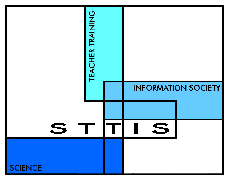Guide
|
Notes
on Section B Learning about the innovation
The main aims of this section
are:
-
To learn how to use the
dynamic nature of a spreadsheet
to explore the effects of changing variables in simple relationships
and
how these can be represented graphically.
-
To learn how spreadsheets
can be used to explore
the behaviour of more complex relationships involving power laws and
several
variables.
-
To learn how a spreadsheet
can be used to model situations
that evolve over time through iteration.
-
To consider the usefulness
of these models in teaching
and learning.
Notes on the activities follow:
An important feature of a
spreadsheet is that it
is possible to change input values, and to see immediately the effects
on the values of the output variables. This is sometimes expressed as
providing
support to answer ‘what if?’ questions. One way of thinking about the
effects
of changes is qualitatively – looking at the direction of the changes,
or what increase and what decreases. Another way is to think about them
quantitatively. In the examples here, the calculations of distance,
time
and speed are more straightforward than the calculations on electric
circuits.
For KS3 pupils, being able to work quantitatively with the former is
expected,
but not with the latter. Pupils are expected however to be able to
reason
qualitatively about electrical circuits.
In the same way that
spreadsheets are able to show
immediately the effects of changing input values on output values, they
can also be used to show the effects on graphical representations of
the
output values. For teachers who have had some simple experiences in
using
spreadsheets this would be a suitable place to start, omitting Activity
B1.
In the examples here,
the graphical representations
of distance, time, and speed are more challenging than the graphical
representation
of Ohm’s Law. In the former case, there are three ways in which the
same
‘journey’ is represented – in tabular form, as a velocity-time graph
and
as a distance-time graph. Pupils need to be able to make the links
between
these multiple representations in order for the pupil to understand the
relationships. The Ohm’s Law graph represents a simple linear
relationship.
The spreadsheet here is useful in that by changing input values, pupils
can see the relationship between these values and the slope of the
graph.
Both of these examples address statements found in KS4 of the National
Curriculum.
Previous activities involved
linear relationships.
The ‘Force and motion’ and ‘Electricity’ examples here both involve
power
laws, though the structure of the models are rather different. For
teachers
who have had experiences in using spreadsheets with graphical
representations
this would be a suitable place to start, omitting Activities B1 and B2.
In the ‘Forces and
motion’ example, the system
evolves over time, and the velocity and time are calculated after
different
time-intervals. This is done directly using formula which relate
velocity
and distance directly to time. They could also be calculated by an
iterative
method (see Activity B5). Calculating directly is a more
straightforward
technique for students to understand, though the advantage of the
iterative
technique is that it can be used in situations where calculating
directly
is too difficult. There is a lot of work that can be done here in
predicting
and interpreting the shape of the graphs as the starting conditions are
changed. Particularly challenging is the case of a positive velocity
and
a negative acceleration (e.g. throwing a ball in the air).
In the ‘Electricity’
example, the calculations
of power in the electrical circuits are ‘one-off’ calculations (the
system
does not evolve over time). What is challenging in these examples
(particularly
in the case of two lamps), is to predict and interpret the qualitative
effects on each of the variables of changing resistance or
voltage.
These examples are very
closely related to the examples
given in the previous activity (Activity B3). It would therefore be
desirable
if Activity B3 was completed before this one. This activity could be
omitted
if desired, or be treated as extension work, before proceeding to
Activity
B5. The ‘Forces and motion’ examples extend the treatment by
considering
force and mass as the input variables rather than acceleration. The
example
with two forces can be effective in bringing out the idea that zero
force
(balanced forces) does not imply no motion. The ‘Electricity example’
extends
the work on power in series circuits (Activity B3) to parallel
circuits,
but otherwise the issues are the same.
This final activity introduces
the technique of iteration
to build ‘evolutionary models’ to explore phenomena which would be
difficult
or impossible to represent analytically. The examples chosen are
terminal
velocity and capacitor discharge. Terminal velocity is included in the
KS4 national Curriculum and can be explored qualitatively at this
level.
However, both of the examples are appropriately dealt with
quantitatively
at post-16 level, and students could then be expected to be able to
understand
how the calculations are carried out, or even to construct such models
themselves. In Activity J1,
case studies of
teachers using a spreadsheet to model capacitor discharge are
discussed;
if it is planned to include activity J1 in the workshop, it would be
very
helpful to have used the capacitor discharge model in this activity. |

 Teaching with computer models
Teaching with computer models

